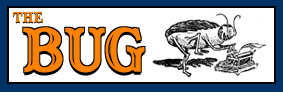“Dig around and find something!” Steve Jevning said, poking through a box of doll heads. “That’s how we do it here. See it, touch it, if something talks to you, grab it!” Jevning is the founder and executive director of Leonardo’s Basement, a South Minneapolis educational center for children of all ages. In a space beneath the Anodyne Coffee Shop on Nicollet Avenue, kids can do anything from computer animation to welding to mummifying Barbie dolls. The place is packed to its dusty rafters with the detritus of salvage shops, electronics warehouses, armament factories, and other enterprises that donate materials. As the pirate captain of this strange organization, Jevning presides over nearly two dozen instructors; in summer the place kicks into high gear, tripling the number of classes it offers.
With his close-cropped hair sprinkled with dust and wood shavings, wireless specs, and muscular hands, Jevning looks every bit the mad inventor. He surveyed the room, his eyes lighting up at a humble cigar-box banjo. “Look at that,” he whispered, admiring its simple design. He absentmindedly began to pluck out a tune. “Children today are a generation removed from Dad’s garage, which is too bad. They’re swept away with Game Boys and television, and there’s not as many cool things to take apart today.” He pulled out his cell phone. “I mean, tear the cover off this and … well, good luck.”
Jevning was once a conventional teacher—the profession runs in his family—but he chafed at all the rules and methods, so he went for remodeling and construction instead. “I hate this miserable return to the Victorian Age, where kids are vessels to be filled, this every-child-left-behind crap,” he said. When he was a student, he pointed out, if he didn’t like a subject in school, he was glad to fail. But then Steve’s fourth-grade son grew bored of his science class and asked his dad to help him and some friends “mess around” after school. Jevning saw this as an opportunity to expand his son’s education.
They rented a space at the Center for Performing Arts and organized an inventors fair. That slowly evolved into classes, fund-raisers, and, finally, Leonardo’s Basement. Jevning’s classes are designed to engage children’s imaginations, teach them simple physics, and give them the confidence to both break and build things en route to solving problems and creating art. And always they’re just plain fun.
Steve pointed to a rather creepy plastic fish with a Barbie-doll head swapped in for a fish head, and its tail fashioned from a larger doll’s hand. It looked like something Duchamp might have played with as a child. “That’s from our ‘Re-Imagined Toys’ class,” he said proudly, as one might talk about the provenance of a valuable sculpture. “Kids get a perverse fascination tearing apart Barbies.”
Leading a visitor down a cluttered corridor, lined with shelves spilling over with plastic tubes and wires, Jevning seemed to be lost in his own mind. “This place is purposely chaotic. Kids need to be given the freedom to roam. The more freedom, the more they expand their space, the more they learn.” He gestured around the room, whose every corner was piled with junk that could be turned into a working machine or work of art: stacks of old keyboards, physics books leaning against doll heads, an upright piano with its innards exposed, medical supplies, blank cds, wood scraps, and wheels—dozens and dozens of wheels. “If we had a giant space they’d make giant stuff!” It appears that if Steve had a giant space, he would make giant stuff as well. “We’d get physical, too. We’d have ropes and pulleys so they could climb. Really get these kids going.”
Enrollment at Leonardo’s Basement is robust—by mid-May there were waiting lists for all the summer sessions—but it is also, not surprisingly, always on financial edge. Jevning is responsible for coming up with a budget, working with donors, and, perhaps most difficult, hunting down teachers who embody the spirit of the school. Too often adults try to impose their own style on the kids, without allowing them their freedom. Good teachers often don’t stay, as their ambitions often send them down a different path.
By summer’s end, children around the city will have floated across Lake Harriet on giant water insects, reconstructed digested mice from owl pellets, and undoubtedly created something no one at the center has ever built before—that spirit of invention is the core of Leonardo’s Basement. As an example of this, Steve stood beside what looked to be a spaceship cockpit. “This is a spaceship cockpit,” he announced. “One of the kids wanted this, so we made it”—using old oscilloscopes, dashboards from music machines, console boards and plenty of gold paint. “Someday this is going to control parts of the basement. The lights, temperature—it will really work. That’s what this place is all about: giving the new da Vincis a salon of their own.”
This article originally appeared in The Rake magazine.
